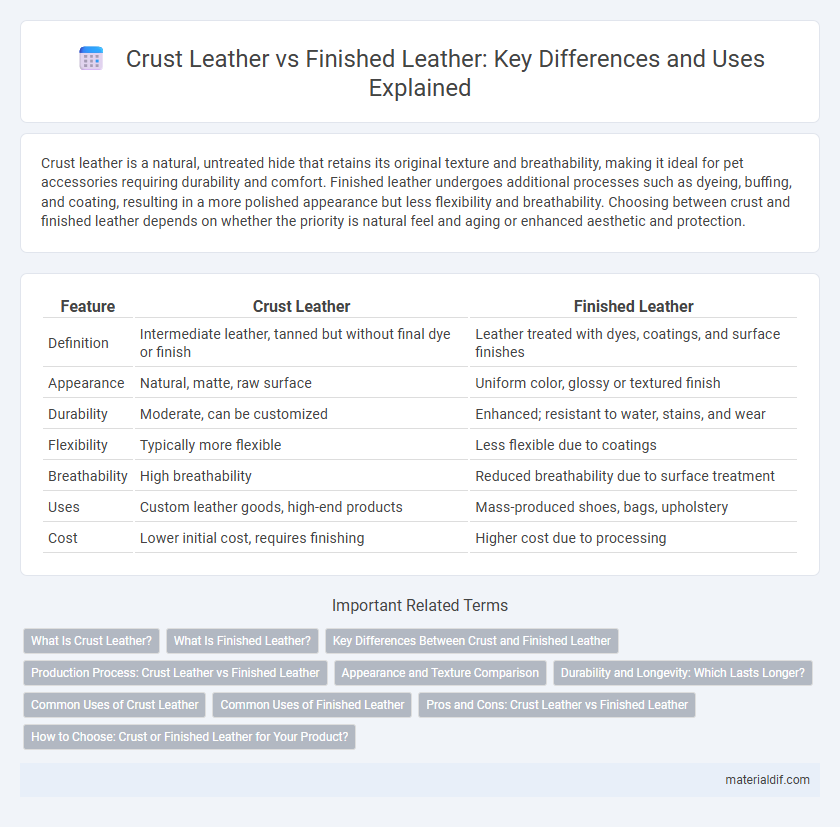Crust leather is a natural, untreated hide that retains its original texture and breathability, making it ideal for pet accessories requiring durability and comfort. Finished leather undergoes additional processes such as dyeing, buffing, and coating, resulting in a more polished appearance but less flexibility and breathability. Choosing between crust and finished leather depends on whether the priority is natural feel and aging or enhanced aesthetic and protection.
Table of Comparison
| Feature | Crust Leather | Finished Leather |
|---|---|---|
| Definition | Intermediate leather, tanned but without final dye or finish | Leather treated with dyes, coatings, and surface finishes |
| Appearance | Natural, matte, raw surface | Uniform color, glossy or textured finish |
| Durability | Moderate, can be customized | Enhanced; resistant to water, stains, and wear |
| Flexibility | Typically more flexible | Less flexible due to coatings |
| Breathability | High breathability | Reduced breathability due to surface treatment |
| Uses | Custom leather goods, high-end products | Mass-produced shoes, bags, upholstery |
| Cost | Lower initial cost, requires finishing | Higher cost due to processing |
What Is Crust Leather?
Crust leather refers to leather that has been tanned but not yet dyed or finished, retaining its natural surface texture and appearance. It undergoes the preliminary steps of tanning and drying, leaving it porous and receptive to subsequent treatments such as coloring, coating, or embossing. This unfinished state allows manufacturers to customize the leather's final look and feel based on specific design or functional requirements.
What Is Finished Leather?
Finished leather is leather that has undergone multiple coating layers to enhance its appearance, durability, and resistance to moisture and stains. It typically features a surface treatment such as dyeing, polishing, embossing, or adding synthetic finishes that provide a smooth and uniform look. This type of leather is preferred in fashion and upholstery for its aesthetic consistency and easier maintenance compared to unfinished or crust leather.
Key Differences Between Crust and Finished Leather
Crust leather refers to hide that has been tanned but not yet dyed or finished, retaining its natural texture and moisture for further processing. Finished leather undergoes additional treatments such as dyeing, surface coating, and embossing to enhance appearance, durability, and water resistance. The key differences lie in crust leather's unfinished state with a rawer feel versus finished leather's polished, protective, and color-stabilized surface.
Production Process: Crust Leather vs Finished Leather
Crust leather undergoes tanning and drying without surface coating, preserving its natural texture and flexibility, while finished leather receives additional treatments such as dyeing, polishing, and protective coatings to enhance appearance and durability. The production process of crust leather involves minimal alteration, making it ideal for custom finishing, whereas finished leather incorporates multiple layers of pigments and sealants during manufacturing to provide uniform color and surface resistance. Understanding these procedural differences aids manufacturers in selecting the appropriate leather type for applications demanding either natural aesthetics or enhanced performance.
Appearance and Texture Comparison
Crust leather features a natural, matte appearance with a soft, supple texture due to its incomplete tanning process, retaining more of the hide's original qualities. Finished leather undergoes additional coatings and treatments, resulting in a glossy, uniform surface and a firmer texture that enhances durability and water resistance. The texture of crust leather feels more breathable and flexible, while finished leather offers a smooth, consistent feel suitable for high-wear applications.
Durability and Longevity: Which Lasts Longer?
Crust leather, being semi-processed and untreated, retains the natural fibers that contribute to its flexibility and breathability but may require more maintenance to prevent wear and deterioration. Finished leather undergoes additional treatments such as dyeing, sealing, and protective coatings, enhancing its resistance to water, stains, and scratches, which generally extends its durability and longevity. Overall, finished leather tends to last longer under regular use due to its protective surface, while crust leather offers a more natural aesthetic with a shorter lifespan unless properly cared for.
Common Uses of Crust Leather
Crust leather, known for its natural, uncolored surface, is commonly used in high-quality leather goods such as shoes, gloves, and handbags that require further finishing or customization. Its flexible and breathable properties make it ideal for products needing a personalized patina or additional coatings. Manufacturers often select crust leather for premium upholstery and artisan-crafted accessories to achieve unique textures and durability.
Common Uses of Finished Leather
Finished leather is commonly used in the manufacture of high-end fashion accessories, including handbags, wallets, and belts, due to its polished appearance and enhanced durability. Upholstery for furniture and car interiors frequently utilizes finished leather for its resistance to stains and ease of maintenance. Footwear production also benefits from finished leather's uniform texture and color consistency, making it a preferred material in both casual and formal shoe designs.
Pros and Cons: Crust Leather vs Finished Leather
Crust leather offers superior breathability and flexibility due to its unfinished surface, making it ideal for high-end leather goods that age beautifully over time, but it requires further processing to enhance durability and protection. Finished leather undergoes additional treatments such as dyeing and coating, providing enhanced resistance to water, stains, and wear, which makes it more suitable for everyday use but can reduce its natural feel and breathability. Choosing between crust and finished leather depends on the desired balance between natural texture and longevity, with crust leather preferred for artisanal craftsmanship and finished leather favored for practicality and ease of maintenance.
How to Choose: Crust or Finished Leather for Your Product?
Choosing between crust leather and finished leather depends on the desired final appearance and usage requirements of your product. Crust leather undergoes tanning but lacks surface coatings, offering flexibility and the option for custom finishes, ideal for artisans seeking personalized aesthetics. Finished leather features protective coatings and dyes, providing durability, water resistance, and a consistent look suitable for mass-produced goods and everyday wear.
Crust leather vs Finished leather Infographic

 materialdif.com
materialdif.com